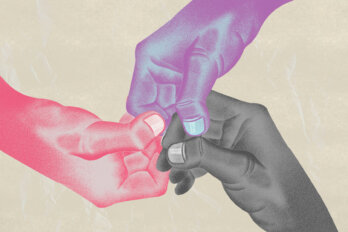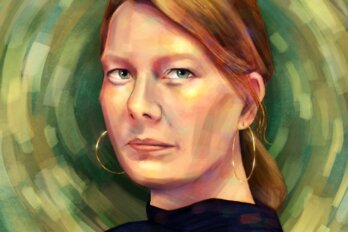Books discussed in this essay
An End to Suffering: The Buddha in the World
by Pankaj Mishra
Farrar, Strauss & Giroux
320 pp., $36
Buddha
by Karen Armstrong
Penguin
205 pp., $19
Suppose for a moment that we really are in crisis. Suppose, too, that the crisis is located not so much in the latest terrorist atrocity or misguided invasion as inside our hearts and minds. It lies within the very notions of who we are, which we have constructed and now can’t sustain. The crisis is the self and, to paraphrase one orange-robed sage, the whole edifice is a house on fire.
The proposition will strike most North Americans as plain silly. For hundreds of years, the autonomous self has been the engine of Western civilization as well as a model for the rest of the planet. Once, medieval Europe had bound identity to clan, church, and king; with the dissolution of that form of life came “the plunge into the adventure of individuality,” as Pankaj Mishra describes it in his extraordinary book An End to Suffering: The Buddha in the World. A new vocabulary for human character evolved during the Enlightenment and Industrial Age, one that emphasized “personal choice and desire and the capacity for self-transformation.” Fresh configurations of nations and economies followed, designed both to encourage and to regulate competing self-interests. Ambitions for liberty and prosperity became good for your country, good for you. One newborn state went so far as to declare the pursuit of happiness a democratic right.
The twentieth century exported this “secular assessment of human possibility” into regions of the globe where it had had virtually no historic foothold. India was a major point of contact (along with China and the rest of Asia) and it was in this country—or in the version of it bequeathed by Prime Minister Jawaharlal Nehru—that Mishra, a thirty-five year old with an ancient soul and a fierce, transgressive intellect, was raised. Here was another young republic that promised its poorest and most downtrodden citizens happiness as European-style rational individuals. Secular education and socialist economic systems, as envisioned by Nehru and his successors, would induce an emboldened India full of individuals empowered to pursue their every private need and desire, even though, as Mishra notes, that notion had “hardly any precedents in India’s own intellectual and spiritual traditions.” This was not, after all, the land of Adam Smith or Karl Marx but, rather, of Mahatma Gandhi and, further back still, Siddhartha Gautama, better known as the Buddha.
An End to Suffering, a cross of biography, memoir, and essay, traverses East and West and back again to gather evidence about the nature of our global predicament. Though Mishra’s debut novel, The Romantics, published in 1999, suggested a serious talent, his reputation is still based more on his work as a literary essayist and a traveller to troubled places. Journeys taken over the past decade into Afghanistan, Pakistan, and Kashmir first alerted him to the legions of mostly young men for whom the fantasy of modernity, of a future where everyone would “wear a tie, work in an office or factory, practice birth control, raise a nuclear family,drive a car and pay taxes,” was collapsing in disappointment. Fundamentalism offered these men an alternative fantasy, the one starring jihad warriors and suicide-bombers in the roles of martyrs.
Then came September 11 and the appearance, at least, of a global clash. An End to Suffering has wisdom to offer about the present state of affairs. The book’s radical proposal, however, involves applying the teachings of an Indian prince-turned-sage who died more than 2,400 years ago. Pankaj Mishra does so despite knowing that the Buddha can be relied upon to make two very contrary, and somewhat baffling, assertions.
The first is that, as usual, the crisis isn’t the one you thought it was—i.e., some external circumstance impeding the universe from unfolding as it should. No, the problem is you: the prison of your desires and illusion of your identity, with its false imperative to achieve some pressing destiny. And the only lasting solution? That is the second assertion, and it is still more astonishing, especially to Western ears. Get out of that metaphorical burning house, the Buddha advises. Out of what? Nothing less than your own presumed-to-be stable self. Get out of it, and quickly.
Buddhism, a friend likes to joke, is religion for accountants. There are the Three Fires and Four Noble Truths, the Five Bundles of Personality and Ten Fetters. The Noble Eightfold Path, which proceeds from the final truth, offers a bonus Threefold Plan of Action. Contained within the twelve links of the Chain of Dependent Causation are terms that are, Karen Armstrong acknowledges in her recent biography, Buddha, difficult to merely understand, let alone put into practice. If the Eightfold Path to enlightenment is less daunting, be grateful for its use of repetition: the Right View, Right Intention, Right Speech, and so on.
The lists, which Armstrong dutifully unscrolls in her straightforward account of the prince who became the lotus sage and the legends from Indian antiquity that cohered into a great Asian philosophy, do serve a purpose. The Buddha was a teacher and preacher both, and his audience was almost certainly illiterate. (Among the many things not known about the real Gautama was whether he himself could read.) Lists aid memorization. They also encourage thinking in terms of process, as when following a manual. The Ten Commandments aside, Christianity can’t touch Buddhism when it comes to columns of edicts and advice. Nor can any other religion manage the same appeal to our own itemizing era, with its fondness for twelve-step programs and Seven Habits of Highly Successful People.
In Srinivas Krishna’s film Masala, two Hindu deities, slumming it as human beings, are about to crash an airplane. “Thank God, we are Gods,” one quips to the other. But while Hinduism, Greek mythology, Judaism and Christianity feature all-powerful gods, the Buddha was having none of this Higher Being business. His business was about being human, and he had no patience for doctrines concerning hierarchies or ultimate reality. He had, in fact, no real theology to impart or philosophy to share. Rather, his fussy lists sketched out, in Mishra’s words, a “medical diagnosis and cure” for suffering that was both psychologically acute and ethical.
The pseudo-philosopher who freebases spirituality with therapy in order to retail a remedy for pain and a path to wellness: sound familiar? Siddhartha Gautama as Deepak Chopra or Dr. Phil? Not quite. Still, the Buddha would definitely qualify for his own prime-time TV spot—at least until the details of his ego-eradicating program of recovery sank in. Then, regardless of any physical resemblances to Keanu Reeves, his ratings are likely to plummet.
I’m Not Me—You’re Not You might be the title of that unpopular show. Negative emotions such as anger, hatred, malice, and jealousy, are caused by a false attachment to such seemingly rock-solid entities as the self and the phenomenal world. A sense of identity isn’t so much problematic as delusional. We don’t exist as autonomous beings, despite what our insatiable hungers and thirsts suggest. Instead, we are part of a complex flow of phenomena in a universe at once impermanent and beyond our control. The Greek philosopher Heraclitus, a near contemporary of Gautama, had a similar idea: “You cannot step into the same river twice.”
Understanding that impermanence, and the interconnectedness it implies, brings far more than release from individual suffering and disappointment. It helps one become a more disciplined person. There is a reason why the Buddha is forever depicted in solitary repose, eyes cast downward. He doesn’t offer a weekly service, let alone a sermon bracketed by hymns. His treatment certainly doesn’t feature healing circles or group hugs. Giving over to one’s desires, or to the authority of a state or even a God, represents a retreat from personal responsibility. You, and you alone, must regulate your mind. You, and you alone, must liberate your actions. A “private remedy for private distress,” is Mishra’s elegant summary, multiplied by six billion.
Both An End to Suffering and Buddha are careful to locate this still singular idea—a challenge, Mishra grants, to the “very basis of conventional human self-perceptions”—in the Buddha’s lifetime. Sixth century BC India saw the breakdown of smaller societies and older moralities and their replacement with the tumult of emerging empires. Traditional consolations of faith and community were vanishing. People feared for their personal security and for the future. “Terror, awe and dread” is how one Buddhist scripture summarized the mood.
That was then. But that is now as well, amid what Mishra calls the “great violence and confusion” of the present day. The young Indian casts a cold eye on what the West has sought to impose upon the rest of the planet. Some of his pronouncements seem almost calculated to inflame. He dismisses the individual of the European model as a creature living “merely for the sake of increasing and satisfying his material needs.” He also declares nearly everything in the modern world to be “predicated on the growth and multiplication of desire.”
Mishra’s trenchant conclusion is this: the political and social arrangements that our autonomous selves have rendered tyrannical must be overcome. The Buddha offers a regimen that can liberate us from the burning house of our unappeasable selves. He outlines a kind of spiritual politics that demands that human beings accept responsibility for their actions and, having been made aware of the interdependency of individuals and societies, behave with compassion and kindness. The flight from individuality will be tough going—our flawed, self-regarding natures, while being a cause of suffering, may also, Mishra admits, be a source of vitality—but the effort alone can constitute the closest thing possible to an ethical life, as well as an antidote to the fanaticism that is spreading like a pox across the globe.
Geography may be destiny here. While An End to Suffering boldly circles the planet of ideas, it sticks physically close to the small patch where Siddhartha Gautama walked the earth. Not so coincidentally, that patch also contains the majority of Mishra’s own footsteps.In both cases, it is the India not of the mystical Himalayas, as the popular imagination would favour—Buddhism migrated north to Tibet only in the seventh century AD—but of the dusty, crowded plains of the Ganges basin. There, unkempt sages and seers wandered the roads begging alms and seeking wisdom, or just escape. They did so in 483 BC, the year of the Buddha’s death, and they do still in 2004 AD. As Mishra researches his subject, he charts the emergence of his own unsatisfactory self amid the exhausted rice fields and villages of mud and straw, where, he writes, “the feeling of being exposed in the vast flatland never leaves you.” Thus do philosophies of being spring from a specific physical setting into the universal consciousness of women and men.
Pop-Buddhism tends to play down its roots in the Asian subcontinent, fearing, perhaps, the severity of that ancestry for those who simply wish to dabble, without ever feeling so exposed. It’s good to be reminded that such fearsome therapy for the problems of being alive emerged from a place where existence is not easily maintained, and where questions about the fundamentals are asked with the same regularity as queries about the weather. In the end, Richard Gere or even Leonard Cohen can’t help you much with this point, although lines from Cohen’s song “Boogie Street” come close to capturing the lay of that distinctive landscape: “So come, my friend, be not afraid/We are so lightly here/It is in love that we are made/In love we disappear.”





